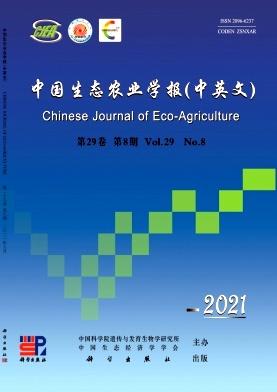垄作稻-鱼-鸡共生对水稻茎秆倒伏、穗部性状及产量的影响
Q3 Agricultural and Biological Sciences
引用次数: 0
Abstract
为了探究水稻垄作栽培和稻-鱼-鸡共生模式的结合对水稻茎秆倒伏、穗部性状及产量的影响,本文通过设计常规水稻垄作栽培(CK)、水稻垄作养鱼(RF)、水稻垄作养鸡(RC)和水稻垄作养鸡养鱼(RFC)的田间对比试验,研究垄作稻-鱼-鸡共生模式下水稻茎秆倒伏、穗部性状和实际产量的变化。结果表明:2年中4个处理的水稻株高、株鲜重、重心高度和节间长的均值整体无显著性差异。与CK处理相比,RFC和RC处理水稻茎秆节间外径、节间壁厚、穗长和穗鲜重虽呈增加趋势,但均值整体也无显著性差异;水稻产量也保持稳定。RF处理水稻茎秆节间外径、壁厚、穗长和穗鲜重均呈降低趋势,且2019年穗鲜重达显著降低(P < 0.05);水稻产量2年平均降低为29.98%(P < 0.05),其余均值整体无显著性差异。2年中RFC和RC较CK处理水稻节间茎秆抗折力平均增加19.69%和8.10%,且2年中RFC的第4和第5节间茎秆抗折力显著增加(P < 0.05);而RF处理茎秆抗弯截面模量和抗折力整体均呈降低趋势,但均值整体变化不显著。RFC和RC较CK处理水稻茎秆节间最大应力均值降低为17.85%和15.08%,倒伏指数均值降低为4.35%和4.26%,但未达显著水平;RF处理茎秆节间倒伏指数平均增加11.47%,且2018年第3和2019年第2~5节间均达显著性差异(P < 0.05)。综上所述,垄作稻-鱼-鸡共生和垄作稻-鸡共生模式能够提高水稻穗长和穗鲜重,稳定水稻产量,增加水稻茎秆节间外径和壁厚,提高茎秆抗折力和抗弯截面模量,降低茎秆最大应力和倒伏指数,从而具有一定的壮秆效应和抗倒伏能力。垄作稻-鱼-鸡共生对水稻茎秆倒伏、穗部性状及产量的影响
In order to explore the effects of the combination of rice ridge cultivation and rice fish chicken symbiotic mode on rice stem lodging, ear traits, and yield, this study conducted field comparative experiments on conventional rice ridge cultivation (CK), rice ridge fish farming (RF), rice ridge chicken farming (RC), and rice ridge chicken fish farming (RFC) to study the changes in rice stem lodging, ear traits, and actual yield under the rice fish chicken symbiotic mode. The results showed that there was no significant overall difference in the mean values of rice plant height, fresh weight, center of gravity height, and internode length among the four treatments over the course of two years. Compared with CK treatment, RFC and RC treatment showed an increasing trend in the internode outer diameter, internode wall thickness, spike length, and fresh weight of rice stems, but there was no significant difference in the overall mean; The rice yield has also remained stable. The outer diameter, wall thickness, panicle length, and fresh weight of rice stem internodes under RF treatment showed a decreasing trend, and the fresh weight of panicles significantly decreased in 2019 (P<0.05); The average decrease in rice yield over the past two years was 29.98% (P<0.05), and there was no significant difference in the other mean values as a whole. Over the course of 2 years, the average increase in internode stem bending resistance of rice treated with RFC and RC compared to CK was 19.69% and 8.10%, and the 4th and 5th internode stem bending resistance of RFC significantly increased (P<0.05); However, the bending section modulus and bending strength of the stems treated with RF showed a decreasing trend overall, but the overall change in mean was not significant. Compared with CK treatment, RFC and RC treatments reduced the average maximum stress between rice stem nodes by 17.85% and 15.08%, while the average lodging index decreased by 4.35% and 4.26%, but did not reach a significant level; The lodging index of stem internodes under RF treatment increased by an average of 11.47%, and significant differences were observed between the 3rd and 2nd to 5th internodes in 2018 and 2019 (P<0.05). In summary, the ridge farming rice fish chicken symbiosis and ridge farming rice chicken symbiosis models can improve the length and fresh weight of rice panicles, stabilize rice yield, increase the outer diameter and wall thickness of rice stem internodes, improve stem bending resistance and bending section modulus, reduce the maximum stress and lodging index of the stem, and thus have a certain stem strengthening effect and lodging resistance.
本文章由计算机程序翻译,如有差异,请以英文原文为准。
求助全文
约1分钟内获得全文
求助全文
来源期刊

Chinese Journal of Eco-agriculture
Environmental Science-Ecology
CiteScore
2.70
自引率
0.00%
发文量
0
 求助内容:
求助内容: 应助结果提醒方式:
应助结果提醒方式:


